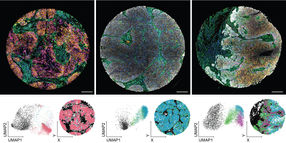Accurate measurement of radioactive thoron possible at last
PTB develops first primary standard worldwide for calibration of thoron measuring instruments
"Many people are now saying: 'Is it really that easy? Then why didn't anyone think of it a long time ago?' But you have to have the right idea at the right time," says Annette Röttger, physicist at the Physikalisch-Technische Bundesanstalt (PTB), in a pleased way. Annette Röttger and her scientific team managed to do something that was previously thought to be impossible: they developed a primary standard for the measurement of short-lived radioactive thoron. Thoron measuring instruments from all over the world will now be calibrated at this unique device which is currently the only one of its kind in the world. This is the basis for accurate measurements of radioactive gas, which occurs naturally in the ground, can collect in living areas and whose progenies are considered carcinogenic.
The same as its sister isotope radon (Rn-222), the radioactive gas thoron (Rn-220) can also cause lung cancer through its progenies if these are breathed in over long periods of time and in high concentrations. The degree of the radiation exposure of living areas varies greatly and is dependent on the construction of the house and the way it is ventilated. The measurement of Rn-222 has worked very accurately for a long time, whereas measuring instruments for thoron have delivered results with considerable uncertainties up till now. And what was worse: sometimes the results were simply wrong! The exact measurement of thoron is, however, important for the estimation of risks, as at the same activity concentration, a 14-fold higher radiation level results from the thoron progenies than from the progenies of the Rn-222, which is already measured well.
"It was clear that all thoron measuring instruments need a uniform standard with which they can be calibrated so that all the measurements are comparable, and so that you know the uncertainty of each individual measuring instrument," explains Annette Röttger. But the development of a standard that is valid everywhere - metrologists speak of a primary standard - like the one that already exists for Rn-222, was considered impossible for a long time, because thoron has a relatively short half-life of only 55 seconds. The PTB team finally had a brilliant idea: The core of the primary standard is a test container which is filled with a defined amount of thoron. In view of the short half-life, a closed container, such as for radon, did not come into question, as the activity would quickly decay in that, in a short time. For this reason the scientists developed a circuit system that constantly introduces newly produced thoron with a high flow air stream and keeps the activity in the container constant.
The production and the accurate measurement of the activity which was fed in, was a metrological challenge. It was possible through a novel measuring arrangement called the thoron emanation measuring facility (TEM). The activity thereby comes from a thorium (Th-228) preparation which continually produces thoron. A constant, strong air stream transports the thoron into the test container. The tough nut that had to be cracked was: how much thoron is transported away and how much stays in the source? The PTB team finally succeeded in determining this ratio to one tenth of a per cent exactly.
Parallel to operating the TEM, the measuring instrument to be calibrated can be connected to the test container. As a rule, all the connected devices show more or less different results. You might even have a factor of 4! The manufacturers then receive a correction factor from PTB with which they have to multiply the measurement result to get to the correct result.
As more and more geological and epidemiological studies in Asia, Europe and Latin America are focussed on thoron (to which little attention had been paid to date), the newly set up measuring arrangement at PTB is constantly fully booked by international customers.
Original publication
Röttger, A.; Honig, A.; Dersch, R.; Ott, O.; Arnold, D.: A primary standard for activity concentration of 220 Rn (thoron) in air. Applied Radiation and Isotopes 68 (2010) 1292-1296
Most read news
Original publication
Röttger, A.; Honig, A.; Dersch, R.; Ott, O.; Arnold, D.: A primary standard for activity concentration of 220 Rn (thoron) in air. Applied Radiation and Isotopes 68 (2010) 1292-1296
Organizations
Other news from the department science

Get the analytics and lab tech industry in your inbox
From now on, don't miss a thing: Our newsletter for analytics and lab technology brings you up to date every Tuesday. The latest industry news, product highlights and innovations - compact and easy to understand in your inbox. Researched by us so you don't have to.
























































